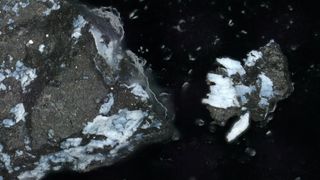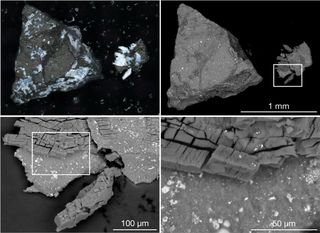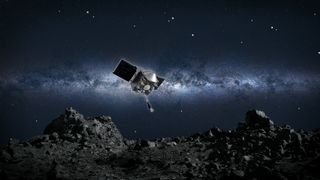
A tiny fraction of the asteroid Bennu sample returned by NASA’s OSIRIS-REx mission, shown in microscope images. The top-left pane shows a dark Bennu particle, about a millimeter long, with an outer crust of bright phosphate
(Image credit: Lauretta & Connolly et al. (2024))
On September 24, 2023, NASA’s OSIRIS-REx spacecraft dropped a capsule to Earth containing pristine carbonaceous regolith collected from the near-Earth asteroid Bennu. These samples were obtained after the probe took an impressive, seven-year roundtrip journey through the solar system and back.
Since these space rock pieces arrived (approximately 120 grams of sample, to be precise) scientists have highly anticipated an analysis of the specimens that can tell us what molecules lie within Bennu. They’ve been hoping to find clues about the history of our solar system, seeing as Bennu should’ve been present when our cosmic neighborhood was coming together, and prebiotic molecules that might provide insights into the origin of life on Earth. It’s possible, many experts speculated, that these samples could host the seeds of other essential ingredients, such as water, that could have contributed to Earth’s habitability if they ended up on our planet, too.
“The sample we returned is the largest reservoir of unaltered asteroid material on Earth right now,” Dante Lauretta, co-lead author of the paper and principal investigator for OSIRIS-REx at the University of Arizona, Tucson, said in a statement.
While initial studies did indeed indicate the OSIRIS-REx samples exhibited evidence of carbon and water, perhaps even more remarkable is the team’s recent, and unexpected, discovery of magnesium-sodium phosphate. This is an ionic compound composed of the magnesium cation (Mg2+) and phosphate anion (PO43-).
Related: NASA’s OSIRIS-REx lands samples of asteroid Bennu to Earth after historic 4-billion-mile journey
On Earth, magnesium-sodium phosphate can be found in certain minerals and geological formations, as well as within living organisms where it is present in various biochemical processes and is a component of bone and teeth. According to a NASA press release, however, its presence on Bennu surprised the research team because it wasn’t seen in the OSIRIS-REx probe’s remote sensing data prior to sample collection. The team says its presence “hints that the asteroid could have splintered off from a long-gone, tiny, primitive ocean world.”
“The presence and state of phosphates, along with other elements and compounds on Bennu, suggest a watery past for the asteroid,” said Lauretta. “Bennu potentially could have once been part of a wetter world. Although, this hypothesis requires further investigation.”
Sign up to our newsletter for the latest updates on rocket launches, skywatching events and more!
The OSIRIS-REx spacecraft obtained a sample of Bennu’s regolith on October 20, 2020 using its Touch-and-Go Sample Acquisition Mechanism (TAGSAM), which comprises a specialized sampler head situated on an articulated arm. Bennu is a small B-type asteroid, which are relatively uncommon carbonaceous asteroids. “[Bennu] was selected as the mission target in part because telescopic observations indicated a primitive, carbonaceous composition and water-bearing minerals,” stated the team in their paper.

The top-left pane shows a dark Bennu particle, about a millimeter long, with an outer crust of bright phosphate. The other three panels show progressively zoomed-in views of a fragment of the particle that split off along a bright vein containing phosphate, captured by a scanning electron microscope. (Image credit: Lauretta & Connolly et al. (2024))
The sample was collected from a site nicknamed Nightingale, which is situated in Hokioi Crater, an impact feature in Bennu’s northern hemisphere that’s about 20 meters (66 feet) in diameter.
Further analysis on the samples revealed the prevailing component of the regolith sample is magnesium-bearing phyllosilicates, primarily serpentine and smectite — types of rock typically found at mid-ocean ridges on Earth. A comparison of these serpentinites with their terrestrial counterparts provides possible insights into Bennu’s geological past. “Offering clues about the aqueous environment in which they originated,” wrote the team.

Artist’s conception of NASA’s OSIRIS-REx spacecraft collecting a sample from the asteroid Bennu. (Image credit: NASA/Goddard/University of Arizona)
While Bennu’s surface may have been altered by water over time, it still preserves some of the ancient characteristics scientists believe were present during the early solar system’s days. Bennu’s surface materials still contain some original features from the cloud of gas and dust from which our solar system’s planets formed — known as the protoplanetary disk.
The team’s study also confirmed the asteroid is rich in carbon, nitrogen and some organic compounds — all of which, in addition to the magnesium phosphate, are essential components for life as we know it on Earth.
“These findings underscore the importance of collecting and studying material from asteroids like Bennu — especially low-density material that would typically burn up upon entering Earth’s atmosphere,” said Lauretta. “This material holds the key to unraveling the intricate processes of solar system formation and the prebiotic chemistry that could have contributed to life emerging on Earth.”
In addition to the important scientific discoveries made during this mission, it underscores the significance of sample return in unraveling the geological and geochemical intricacies of asteroids like Bennu, and their implications for the formation and evolution of the solar system.
“The data we have presented here are only the tip of the iceberg: there is likely more about the sample that we do not know than we do know,” concluded the scientists.
Join our Space Forums to keep talking space on the latest missions, night sky and more! And if you have a news tip, correction or comment, let us know at: [email protected].
A chemist turned science writer, Victoria Corless completed her Ph.D. in organic synthesis at the University of Toronto and, ever the cliché, realized lab work was not something she wanted to do for the rest of her days. After dabbling in science writing and a brief stint as a medical writer, Victoria joined Wiley’s Advanced Science News where she works as an editor and writer. On the side, she freelances for various outlets, including Research2Reality and Chemistry World.
>>> Read full article>>>
Copyright for syndicated content belongs to the linked Source : Space.com – https://www.space.com/nasa-osiris-rex-sample-return-phosphate-ocean-world































